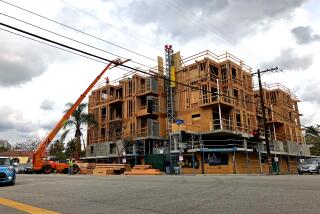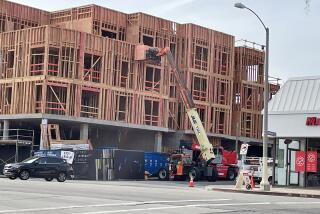City Approves Language to Keep Single-Family Neighborhoods Intact
- Share via
San Diego City Council members, completing a package of protections for the city’s topography and turning their attention to managing growth, Thursday approved strong language protecting single-family neighborhoods.
The council approved wording that would ban the demolition of single-family homes if they are to be replaced by multifamily dwellings. Such a ban would remain in effect during a citywide study of neighborhoods by the Planning Department if voters approve the city’s landmark Growth Management Plan at the polls Nov. 8.
But council members indicated their willingness to invoke the ban sooner by instructing planners to draft an ordinance that could take effect within the next few weeks.
The measure is part of the growth-control blueprint being debated and completed this week by the City Council.
Sorrento Valley Parcel Exempted
Earlier Thursday, the council wrapped up a package of environmental restrictions that are part of the growth-management document by exempting a 166-acre Sorrento Valley parcel from strict provisions that limit building on hillsides, wetlands, canyons and in flood plains.
The city is trading the parcel, known as Sorrento Hills, to the Newland California development company for 291 acres in Los Penasquitos Preserve, a swap approved by city voters in 1986. The exemption, approved by a 6-3 vote, will allow Newland to build a 100-acre business park on the Sorrento Hills parcel.
The decisions came on the fourth day of council deliberations on the Growth Management Plan that, if approved by voters, will guide the city’s growth into the next century. The comprehensive package will compete on the Nov. 8 ballot with a similar, but generally stricter, growth-control plan written by a citizens group.
General Plan Amendment
The plan that receives the most votes will become an amendment to the city’s General Plan.
The issue of demolishing single-family homes for the purpose of building multifamily dwellings was contained in a section of the package dealing with neighborhood preservation.
The measure is aimed at inner-city areas where residents have objected to the replacement of single-family homes by small, multifamily dwellings, and includes long-term protection for single-family neighborhoods.
In neighborhoods deemed “transitional,” the growth-control plan calls for an “orderly” switch from single-family to multifamily dwellings by requiring a special permit that ensures “compatibility with the existing character of the neighborhood.”
Complaint by Building Industry
Building industry representatives said a ban on replacement of single-family homes will hurt property owners who want to convert their homes and builders who earn a living working on small, inner-city projects.
“I think for the smaller builder that does in-fill development, it could put him out of business,” said Kim Kilkenny, legislative counsel for the Construction Industry Federation.
But council members have strongly endorsed the section throughout months of debate on the plan as necessary to preserve neighborhood character.
Earlier Thursday, the council wrapped up its deliberations on environmentally sensitive lands and indicated that it will consider enacting those protections before November by passing an interim ordinance.
Otay Mesa Exemption Rejected at Filner’s Behest
At the suggestion of District 8 Councilman Bob Filner, the council instructed the city’s Planning Department to present it with such an ordinance when the plan comes back for a final review and placement on the ballot next month.
The council declined to exempt a 2,280-acre section of Otay Mesa from the environmental restrictions, telling developers who want to build as many as 19,000 homes in the area that they will have to appear before the council after the November election and petition for special exclusion from the rules.
City planners have said that the environmental restrictions, if enacted, would prohibit construction on 1,400 acres of the land, reducing the number of homes that could be built from 19,000 to about 6,500.
The council left the most controversial aspects of the Growth Management Plan, including a proposed home-building cap, for consideration today.
More to Read
Sign up for Essential California
The most important California stories and recommendations in your inbox every morning.
You may occasionally receive promotional content from the Los Angeles Times.










